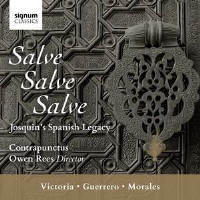Texte paru dans: / Appeared in:
Signum |
|
|
Outil de traduction ~ (Très approximatif) |
|
|
Reviewer: J.
F. Weber
The program, subtitled
Josquin’s Spanish Legacy, features Victoria’s Missa Gaudeamus. It is
preceded by the opening piece on which it is based, Jubilate Deo omnis terra
by Cristóbal de Morales. A member of the papal choir, Morales composed the
piece in 1538 for a meeting of the Holy Roman Emperor Charles V and Francis
I of France with Pope Paul III, who was brokering a truce between the two
most powerful rulers of Europe. The music has lasted much longer than the
short-lived peace. While five voices sing a text praising Carolus,
Franciscus, and Paulus, the tenor voice repeats a six-note ostinato on the
first word of the introit antiphon, “Gaudeamus.” This is the same ostinato
that Josquin used in his Missa Gaudeamus, which was based on the chant
antiphon. Victoria then used the same ostinato in his Missa Gaudeamus, which
was based on this motet. Between the two works, Rees performs the antiphon
of the underlying chant introit.
This is an effective way of
demonstrating Josquin’s Spanish legacy, which descended through Morales to
Victoria. Another example is Josquin’s five-voice setting of Salve Regina
(even more popular on records than his four-voice setting), preceded on the
disc by the chant antiphon. It also uses ostinato technique based on the
four notes of “Salve,” perhaps the most prominent use of ostinato in
influencing two generations of Spanish composers. Victoria used the
technique in his six-voice motet setting, one of four that he composed (the
one for eight voices is the most recorded), outdoing his predecessors by
adding a second ostinato on “mater misericordiae.” The Victoria motet is
inserted within the Mass movements.
Rees is not done with his
examples. Francisco Guerrero, a slightly older contemporary of Victoria, is
represented by two motets, one using the ostinato technique, the other using
canon. His most famous motet, Ave virgo sanctissima, adopts the latter
approach with the four-note motto of “Salve” in the two superius voices. The
program concludes with Surge propera, amica mea, a motet on a text from the
Canticle of Canticles, a love poem in the literal sense, which Guerrero
turns into a Marian devotion by inserting an ostinato “veni sponsa Christi”
into the text. It is taken from the seventh-mode antiphon at second Vespers
for the common of virgins, a simple six-note motive that serves his purpose
most effectively when it occurs at the end of the motet, where the last word
of the text, “veni,” coincides with the ostinato “veni sponsa Christi,” the
last word ringing out on a top Eb. Rees is a scholar and conductor of uncommon insight. He has devoted himself to several areas of Renaissance polyphony for decades, recording with several ensembles. Contrapunctus, founded a decade ago, has now made five CDs for Signum, applauded in these pages by my colleagues and myself (43:1). He uses 12 singers here, fewer in some works (the group photo shows a basic group of eight). He assigns the introit to a male soloist, while female and male soloists alternate phrases of the antiphon; I like his straightforward interpretation of the two chants. The Victoria Mass has had five fine recordings, Michael Noone’s version in his big box (43:4) and Andrew Carwood’s earlier version (23:5) being outstanding. Rees’s group is ravishing, bringing the listener to moments that one marvels at (“et homo factus est” in the Credo). The highlight of the program is the opening motet Jubilate Deo, previously recorded by Stile antico (38:3), Alistair Dixon on this label (29:1), and A Sei Voci (13:1). Hearing it first on the disc prepares the listener for the felicities of Josquin’s legacy. This is an uncommonly fine program and recording, not to be missed. | |
|
|
|
|
Cliquez l'un ou l'autre
bouton pour découvrir bien d'autres critiques de CD |
|




